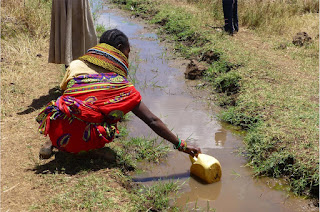Water is
life's . . . mother and medium. There is no life without water.
Albert Szent-Gyorgyi
Water is life, and clean water means health.
Audrey
Hepburn
There is this thing, the “rule of threes:” You can live for
3 minutes without oxygen, 3 days without water and 3 weeks without food. Look
into this and you’ll find that there are, of course, exceptions. But it does
put into perspective the sense of urgency required when addressing insufficiencies
in these vital elements of life.
The purpose of Global Hope Network International’s (GHNI)
Transformational Community Development (TCD) program is to bring villages mired
in extreme poverty to a state of sustainable self-sufficiency. There is
structure to the approach. When a village is engaged, projects are planned in
the areas of Water, Nutrition, Wellness, Education, and Income Generation. Project details are
based on the current state of the village. But the village is ALWAYS expected
to actively participate in planning and executing the projects, to engage in
the coaching that is central to TCD, and carry out their roles to the best of
their ability.
You might guess from the rule of threes that water is a big
deal. And it is. But it might be even more important than you imagine. This is
the first of three four (I had more to say than originally planned, I guess!) posts in which I share my experiences with TCD water
projects in two villages in central Kenya.
It was a water project that introduced me to TCD in action
during my first visit to central Kenya in 2011. Then, in 2014, I saw first-hand
the issue of water in a new light; it broke my heart and steeled my commitment
to provide whatever help I could to the TCD program.
Bulesa Dima was my introduction to the villages in the area
around Isiolo Town in central Kenya. It is at once beautiful and terrible.
Stunningly picturesque; hot and dry. OK to visit; hard to live in. I have had
five opportunities for the former, but never the struggle of the latter.
After the stop there, we moved on to visit the four other TCD
villages. Of particular interest to me was the time we would spend at Ola
Nagele, then the newest village in the program and the one for which I had
become one of one-hundred sponsors in 2010.
Ola Nagele is conveniently located just over 3 miles north
of the center of Isiolo Town and just off the paved highway that runs to the
Ethiopian border, 257 miles away. Convenient, because the people have access to
the town with its markets and because there is a municipal water line running
alongside of the highway. But nearby and accessible are not the same thing.
People in Ola Nagele, as did those in villages farther out
in the rough bush, had to go out and find, collect, and carry water every day.
Here is how Wubshet and Habiba Mengesha, GHNI’s National Leaders in Kenya,
described the early days as GHNI began to bring the village into the TCD
program:
“When GHNI started their program in
Ola Nagele, the main challenge which the community faced was water; no borehole
or water stream nearby, but rather the people walk over 5 to 10 km in search of
this precious commodity. The main Isiolo water pipe could not supply this
village simply because the communities are poor and they could not afford the
pipes to pull the water from the main pipe which passes by the main highway.”
It might have been fairly easy for GHNI to arrange a
connection to the water line, but that is not the way the program works. Here
is more from Wubshet and Habiba on how things progressed:
“… we established the (village water) committee
and brainstorm on how to go about this problem in conjunction with Isiolo Water and Sewerage Ministry ...”
There is important information in this statement. All villages
engaging in the TCD program appoint leaders and form committees for TCD focus
areas. GHNI staff mentor the committees as they look for low cost, low tech,
locally appropriate solutions to the problems they are charged with solving. Some
of the most important contributions to the village occur in meetings with the
GHNI staff.
Habiba discusses
water project with the village elder
It was probably obvious that connecting to the municipal
supply would be the easiest way to supply the village. So, discussions included
the Isiolo Water and Sewerage Ministry.
Through their active participation in the meetings, village leaders learned
important skills in relating their situation to others who might be engaged in
a solution.
What happened as a result of
the meetings? Again, we hear from Wubshet and Habiba:
“...we bought pipes and community
digged the trench over 2 km and we also built a tower tank in a central
position where everybody could come and fetch the water at small fee for
maintenance ...”
Raising the tank onto
the base
The village welcomed the
flowing water as soon as it was let through the pipe from the municipal supply
and further celebrated when the large storage tank was mounted on its base and
connected to the piping ...
The village could, for the first time, look forward to a
nearby, ready supply of clean water. It was a good time for sure.
Coming up next: Life’s not all Daisies and Hot Dogs
Coming up next: Life’s not all Daisies and Hot Dogs


































